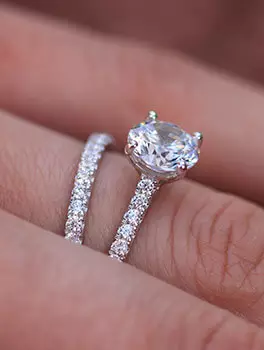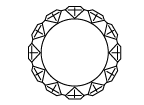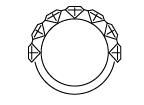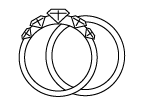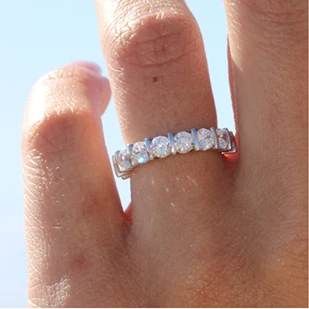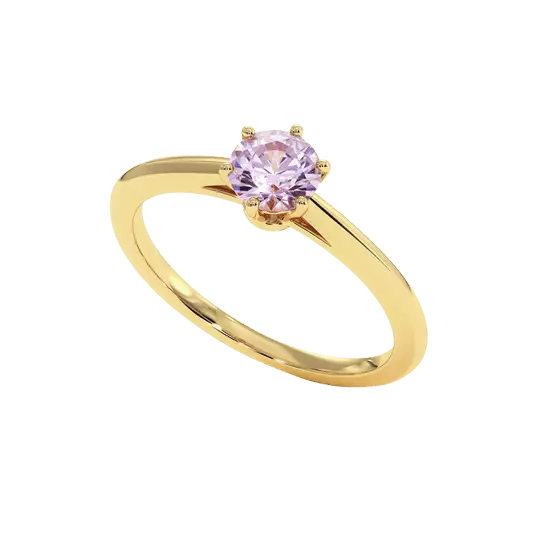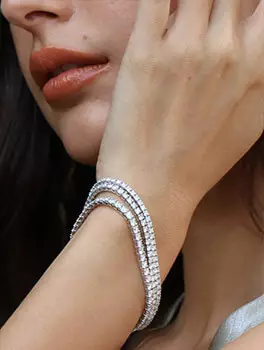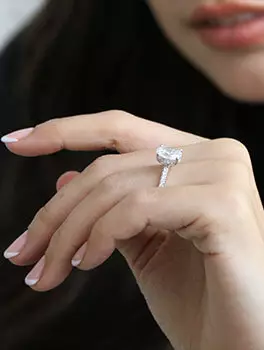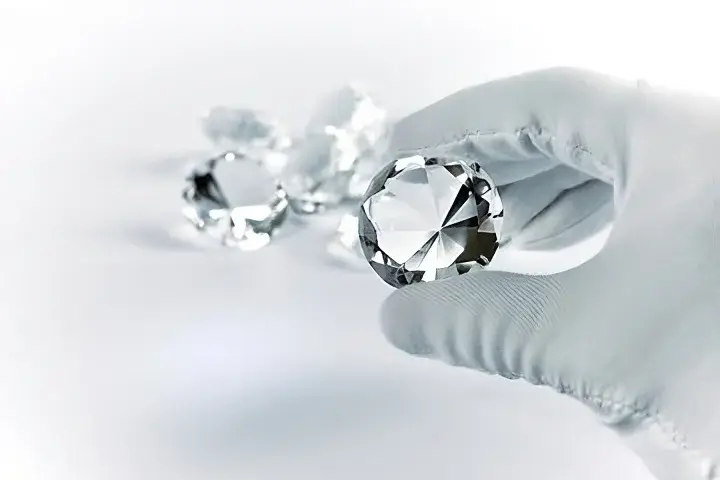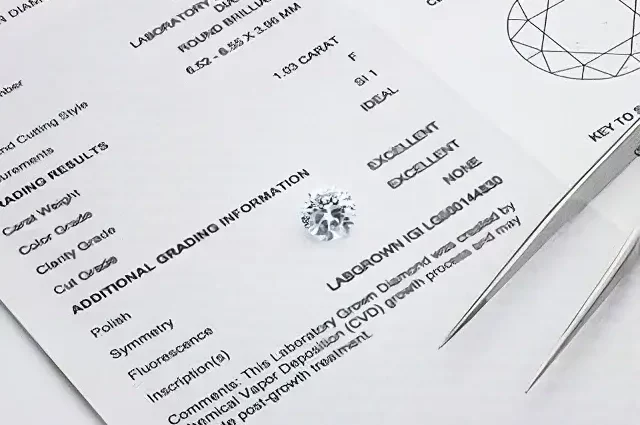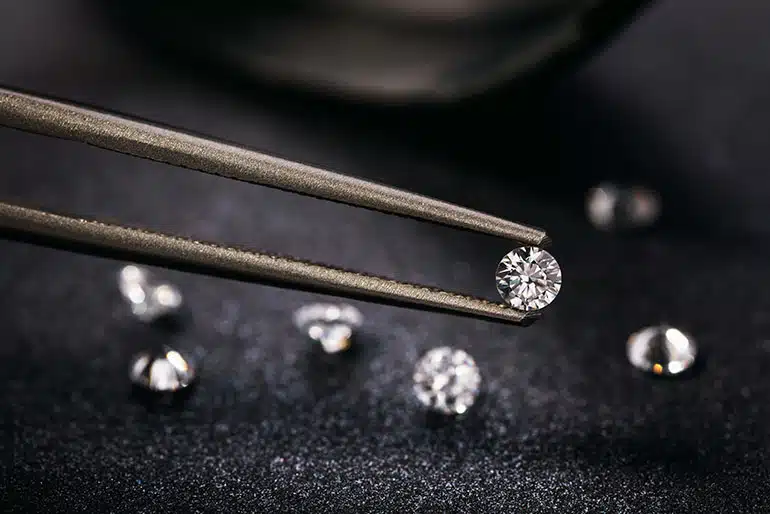International diamond certificates
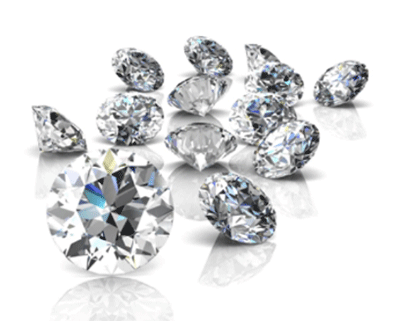
Each diamond is unique, no diamond is alike and no diamond will have the same characteristics as another. They are like us, every human is different and will present different characteristics.
To identify themselves, a human has an identity card or a passport. For the diamond the concept also exists, except that it is called a gemology certificate. We will study in this guide the GIA certificates, (Gemological Institute of America), the HRD (High Diamond Council) and the IGI (International Gemological Institute).
(Fact: the diamonds of the Celinni are certified by these laboratories)
WHAT IS A GEMMOLOGY CERTIFICATE?
A certificate is the identity card of the diamond. It appeared in the 1970s, which disrupted the customs of the profession. It's the arrival of a new standard. This certificate has value if and only if it is certified by an approved laboratory.
WHAT ARE THE CHARACTERISTICS OF A GEMMOLOGICAL CERTIFICATE?
With this certificate, two diamonds cannot be confused. It is actually a leaflet, sometimes laminated, on which all the characteristics of the diamond are noted. (Fact: for a diamond to have a certificate it must have been appraised). Each laboratory has its own certificate format, large, small etc. Laboratories can also offer additional services such as the option to seal the diamond in a plastic box or laser engraving the certificate number on the diamond.
WHAT IS WRITTEN ON THE DIAMOND CERTIFICATE?
The diamond's full characteristics will be listed on this certificate. Just like us, on our ID card: our first name, our last name, our date of birth, our height... are listed. For the diamond it's the same, the certificate will generally indicate:
The shape of the cut (round, emerald, pear, heart...) The weight of the diamond in carats Its purity expressed in degree (SI1, VVS2...) Its degree of color (D, E, F ...) Its fluorescence (weak, medium, strong...) Its proportions (Beware only and only if it is a brilliant/round diamond) The polishing The symmetry of the diamond The entirety of its dimensions namely: height or thickness, diameter (minimum and maximum) in millimeters The size of the culet, the % of the table, the thickness of the girdle...
The small defects of the stone will be noted in the comments but the inclusions will be "drawn" and represented on a diagram of the stone called top and bottom view diagram To finish: the date on which the certificate was made Each laboratory will have its specialty. For example, the GIA certificate prefers to indicate the quality of the diamond while the HRD certificate will prefer to indicate the proportions of the diamond. When you buy a diamond with its certificate, it is possible to check on the laboratories' websites their existence. You enter the certificate number and the carat weight of the diamond. Thus, you will also be able to verify the true background of the information present on your certificate.
HOW TO OBTAIN A DIAMOND CERTIFICATE?
There are different ways to get a certificate for your diamond. The first is the simplest, when buying a Celinni jewel, the certificate will be delivered to you if you wish. But if for example you have just inherited a ring from your grandmother and you do not know if it is a real diamond. You can make your expertise request on the laboratories' website directly or you can approach a gemologist expert who will allow you to have a certificate. Indeed, many diamond dealers, independent gemologist experts work with the largest laboratories.
To certify a diamond, the delay varies from one laboratory to another. The scale ranges from 24 hours to several days or even weeks.
What is the cost of a certificate? Again, it varies depending on the laboratories. The scale can range from a few tens of euros to several hundred euros. This will depend on the carat weight of the diamond and the type of certificate you want.
(Fact: if you buy a diamond directly from the IGI laboratory, for example, the diamond can be sealed in a transparent box. This means that there will be no possible dispute, you must of course check if the box has not been opened in the meantime. Not all laboratories do this, this method is most often replaced today by laserscribe. This is a laser inscription directly on the girdle with the certificate number and the laboratory name as on the GIA certificate. This inscription is invisible to the naked eye).
WHAT ARE THE MAIN LABORATORIES?
There are several laboratories but the main ones are: the GIA (Gemological Institute of America), the HRD (High Diamond Council) and the IGI (International Gemological Institute).
THE GIA CERTIFICATE (GEMOLOGICAL INSTITUTE OF AMERICA)
The GIA is present in various countries: United States, Israel, Thailand, South Africa, Hong Kong, Japan, Botswana, and Belgium. Its headquarters is in Los Angeles. It is the most famous and reputable laboratory in the world. Recognized by professionals for the reliability of its analyses and its trustworthiness, this laboratory is perfect for diamond expertise and more!
The GIA is also famous because it created and introduced the international classification system. It was founded in 1931 and has since been the reference for diamond expertise.
HOW TO READ A GIA CERTIFICATE?
The certificate number: each laboratory has its own numbering system. Dimensions, measurement of a diamond's diameter: "Minimum diameter / Maximum diameter / Depth" are displayed and are values calculated to the hundredth of a millimeter. The shape and size: the shapes of the diamond: round, pear, heart, oval, and square... The cutting styles: Brilliant, marquise, emerald, princess... The weight: diamonds are weighed to the thousandth of a carat thanks to a digital scale. On the certificate, the weight of the diamond is mentioned to the hundredth of a carat or even to the thousandth for some laboratories. More information on the GIA certificate: GIA laboratory website.
THE HRD CERTIFICATE
The HRD specializes in diamonds. It is even considered the High Council of Diamonds. It is the most recognized official institution in the diamond trade and industry in Europe. The headquarters is located in Antwerp, the global center of diamonds. But it is also present in India and Turkey. However, compared to the GIA certificate, some things change: It replaces the term Internally Flawless or IF for pure stones with the expression Loupe clean It does not indicate the percentage of the total height but details those of the crown and pavilion It indicates in the girdle section the height of it in % in addition to the thickness criterion Finally it does not detail in the Finish category the polish and symmetry The HRD laboratory is known as an excellent laboratory and very reliable in its analyses. (Fun fact: this laboratory has set up a double code. One code is given to the owner of the diamond, the other is used by the laboratory. Thus, no HRD gemologist can know who owns the diamond he must examine). More information about the HRD laboratory: HRD website
THE IGI CERTIFICATE
Founded in 1975 with laboratories present all over the world: Antwerp, New York, Bangkok, Mumbai and Tokyo, this laboratory also has the particularity of carrying out expertise on colored stones and finished jewelry. What are the characteristics of IGI: It classifies polish and symmetry in the same category When GIA uses numerical values (in percentage or degree) for proportions, the IGI laboratory uses a quality status (good, very good...) It does not indicate the percentage of the total height but details those of the crown and pavilion On each certificate there is a small unfalsifiable hologram at the bottom to guarantee its authenticity All these laboratories offer services that show the same thing: a precise evaluation of the size, clarity, color, carat weight... More information about the IGI laboratory: IGI website
The certificate is the identity card of the diamond. This piece of paper gives us all the information there is to know about the diamond. We can know if it is treated, natural or its purity, color and even its fluorescence.
In fact, all the characteristics of the diamond visible or not to the eye are written on the certificate. But it is also a document that proves that your stone is a real diamond and sold legally. (Fun fact: there are "blood diamonds" which are diamonds sold illegally. The money made with these sales is used to fuel conflicts and wars)
Will the certificate be the same if the diamond is certified by 2 different laboratories?

Even though these three organizations all comply with the standards set by the IDC (International Diamond Council), there are sometimes differences in the verdict given.
There are rankings for the different characteristics of a diamond so that we can distribute the diamonds into "categories". For example, there is a ranking for the color and purity of the diamond.
Our professionals, through their experience, have captured these small discrepancies in the classification of color and clarity. Indeed, some laboratories will have different requirements. It is therefore likely that a certificate issued by the GIA may not be exactly the same as a certificate issued by the IGI or the HRD.
Below you will find two charts that will allow you to know the strictest laboratories according to the classification of purity and that of color.
WHY DOES THIS DIFFERENCE EXIST?ElleCould you please provide the text you want me to translate?
Sometimes, within the same laboratory, two experts may not agree on what color to give the diamond or what purity. This is because there are stones that are difficult to distinguish. A stone can really be on the border between two colors or two purities, the expert or the Diamond Grader can then decide to classify the stone in one category or the other.
That's why, depending on the experts and laboratories, there can be divergent opinions and therefore different results.
For example: a diamond graded as color F in one laboratory may be graded as color G in another. For more information on diamond color, click here.
Or, a diamond rated as VS1 purity in one laboratory may be rated as VS2 purity in another laboratory. For more information on diamond purity, click here.
Be careful, the verdict can be different between laboratories but also within the same laboratory. Indeed, the classification of laboratories, althoughelle be done in a very rigorous manner and according to well-established processes, is subject to a certain subjectivity and the vagaries of human perception, a stone can then be submitted to the same laboratory six months apart and receive two different verdicts...
DOES THE PRICE OF THE DIAMOND VARY DEPENDING ON THE LABORATORY?
The price of a diamond varies depending on the laboratory. Among the three major laboratories: the GIA and the HRD deliver the most expensive diamonds, while diamonds certified by the IGI are relatively cheaper.
Our estimate on the level of requirement of different laboratories regarding PURITY in relation to IDC standards:
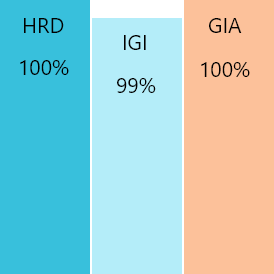
Our estimate on the level of requirement of different laboratories regarding COLOR in relation to IDC standards:
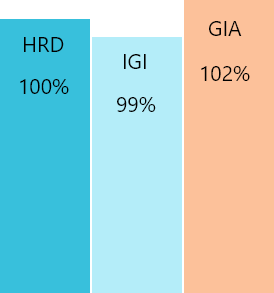
SOME ESSENTIAL DEFINITIONS FOR READING A CERTIFICATE
THE PROPORTIONS
They are described in two points: the table percentage and the depth percentage, both of which are expressed in relation to the diameter of the stone representing 100%. The diamond's table represents the flat part of the stone. The ratios correspond to the relationship between the diameter and the size of the table, as well as the relationship between the height of the stone and the diameter of the diamond. These factors, which should not be overlooked, determine the brilliance and fire of the diamond through optimal light reflection.
THE DIAMOND CUTTER
The roundel is the line that separates the crown (upper part of the diamond) from the pavilion (lower part of the diamond). The certificate describes its condition: very fine, fine thick, faceted, polished etc...
"FINISH", POLISH AND SYMMETRY FOR THE BRIGHTNESS OF THE STONE
The term "finish" defines the polished quality of the stone as well as its symmetry. The symmetry of the diamond is judged by the alignment of the facets in relation to each other. It is very easy for an expert to highlight these properties with a magnifying glass.
THE PURITY OR CLARITY GRADE
The purity of a diamond is referred to in acronyms: IF (for a pure diamond) and in decreasing order VVS1 (very very slight inclusion), VVS2, VS1 (very slight inclusions), VS2, SI1 (slight inclusions), SI2, I1 (inclusions or blemishes), I2 and finally I3. The purity quality of a diamond is assessed by classifying the inclusions by their size, weight, color and nature. Diamond dealers examine diamonds using a microscope and a x10 magnifying glass, which allows them to determine the nature of the inclusions.
THE COLOR OR COLOR GRADE
There is a ranking from D to Z, D being the most exceptional color, colorless and pure, Z being very yellow or brown.
THE FLUORESCENCE
This feature relates to the diamond's ability to fluoresce when it is exposed to ultraviolet light. As a general rule, the more fluorescence, the less valuable the diamond is, but this is not always true, especially for so-called "low" colors like K and L, where fluorescence can make the stone appear whiter by masking the yellow or brown tint with a shade of blue.
THE "PLOT"
This is a graphical representation of the stone and its imperfections. Each diamond is unique, just like a fingerprint. This representation allows laboratories to identify each stone and make it unique compared to others.
COMMENTS
The comments are used to mention the peculiarities of the stone.
WHY IS IT IMPORTANT TO HAVE A GEMMOLOGY CERTIFICATE?
The certificate is very important on the one hand to know the characteristics of the diamond and on the other hand not to be fooled! It is easy today to pass off an artificial or synthetic diamond as a real diamond, yet it is mentioned on the certificates whether it is a natural diamond or a synthetic diamond. There is also a large counterfeit market, some do not hesitate to almost identically copy the certificates of large laboratories. Therefore, it is necessary to be very vigilant and to inform oneself!
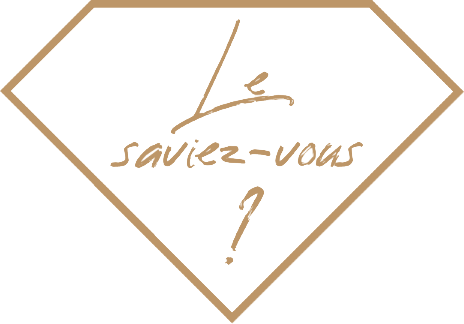 1) The IDC is a propagator of consumer confidence in polished diamonds. It was created 40 years ago. It formulates a set of internationally recognized standards for the grading and nomenclature of diamonds that are applicable in the same way all over the world. It standardizes working methods and encourages recognized institutes to apply these accepted standards and methods.
1) The IDC is a propagator of consumer confidence in polished diamonds. It was created 40 years ago. It formulates a set of internationally recognized standards for the grading and nomenclature of diamonds that are applicable in the same way all over the world. It standardizes working methods and encourages recognized institutes to apply these accepted standards and methods.Advice from the diamond dealer:
- If you choose a certified diamond, don't forget to demand a certificate for it.
- If you have any doubts about the origin or authenticity of a diamond you wish to purchase, we advise you not to buy it and to refer to a professional. At Celinni, you will find diamonds certified either by us (as we are accredited), or by one of the 3 laboratories mentioned previously.
- Before buying a diamond, we advise you to learn about the different characteristics of this stone. This will allow you to be confident. Find here, the four main characteristics of the diamond.
Do not hesitate to contact us for more information on diamond certificates, we will be delighted to answer you.
Also find:








NEWSLETTER
Sign up to receive the latest news regarding
the products and services CELINNI, and much more.





















